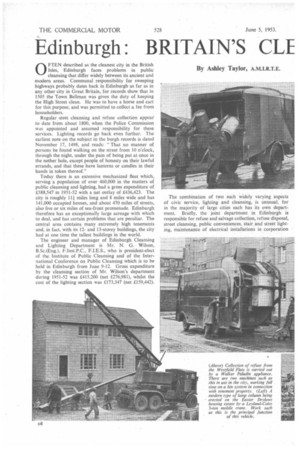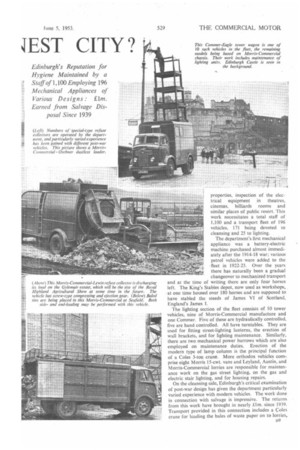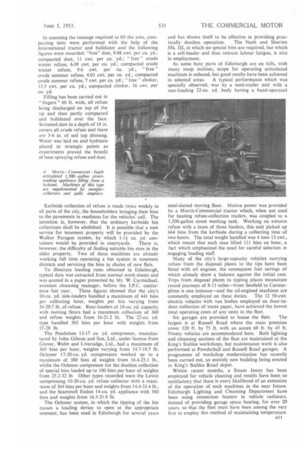Edinburgh • BRITAIN'S CU
Page 48

Page 49

Page 50

Page 51

If you've noticed an error in this article please click here to report it so we can fix it.
.EST CITY?
By Ashley Taylor, A.M.I.R.T.E. 0 FTEN described as the cleanest city in the British Isles, Edinburgh faces problems in public cleansing that differ widely between its ancient and modern areas. Communal responsibility for sweeping highways probably dates back in Edinburgh-as far as in any other city in Great Britain, for records show that in 1505 the Town Bellman was given the duty of keeping the High Street clean. He was to have a horse and cart for this purpose, and was permitted to collect a fee from
householders. .
Regular steet cleansing and refuse collection appear to date from about 1800, when the Police Commission was appointed and assumed responsibility for these services. Lighting records go back even further. The earliest note on the subject in the burgh records is dated November 17, 1498, and reads: " That no manner of persons be found walking on the street from 10 o'clock, through the night, under the pain of being put at once in the nether hole, except people of honesty on their lawful errands, and that these have lanterns or candles in their hands in token thereof."
Today there is an extensive mechanized fleet which, serving a population of over 460,000 in the matters of public cleansing and lighting, had a gross expenditure of £588,547 in 1951-52 with a net outlay of £436,423. The city is roughly 111 miles long and 8 miles wide and has 141,000 occupied houses, and about 470 miles of streets, also live or six miles of sea-front promenade. Edinburgh therefore has an exceptionally large acreage with which to deal, and has certain problems that are peculiar. The central area contains many extremely high tenements and, in fact, with its 12and 13-storey buildings, the city had at one time the tallest buildings in the world.
The engineer and manager of Edinburgh Cleansing and Lighting Department is Mr. N. G. Wilson, B.Sc.(Eng.), F.Inst.P.C., F.I.E.S., who is president-elect of the Institute of Public Cleansing and of the International Conference on Public Cleansing which is to be held in Edinburgh from June 9-12. Gross expenditure by the cleansing section of Mr. Wilson's department during 1951-52 was £415,200 (net £276,981), whilst the cost of the lighting section was £173,347 (net £159,442). The combination of two such widely varying aspects of civic service, lighting and cleansing, is unusual, for in the majority of large cities each has its own department. Briefly, the joint department in Edinburgh is responsible for refuse and salvage collection, refuse disposal, street cleansing, public conveniences, stair and street lighting, maintenance of electrical installations in corporation properties, inspection of the electrical equipment in theatres, cinemas, billiards rooms and similar places of public resort. This work necessitates a total staff of 1,100 and a transport fleet of 196 vehicles, 171 being devoted to cleansing and 25 to lighting.
The department's first mechanical appliance was a battery-electric machine purchased almost immedi
ately after the 1914-18 war; various petrol vehicles were added to the 'fleet in 1922-23. Over the years there has naturally been a gradual changeover to mechanized transport and at thc time of writing there are only four horses left. The King's Stables depot, now used as workshops, at one time housed over 180 horses and are supposed to have stabled the steeds of James VI of Scotland, England's James 1.
The lighting section of the fleet consists of 10 tower vehicles, nine of Morris-Commercial manufacture and one Commer. Five of these are hydraulically controlled, five are hand controlled. All have turntables. They are used for fitting street-lighting lanterns, the erection of wall brackets, and for lighting maintenance. Similarly, there are two mechanical power barrows which are also employed on maintenance duties. Erection of the modern type of lamp column is the principal function of a Coles 3-ton crane. More orthodox vehicles corn-, prise eight Morris 15-cwt. vans and Leyland, Austin, and Morris-Commercial lorries are responsible for maintenance work on the gas street lighting, on the gas and electric stair lighting, and for housing repairs.
On the cleansing side, Edinburgh's critical examination of post-war design has given the department particularly varied experience with modern vehicles. The work done in connection with salvage is impressive. The returns from this work have brought in nearly Lim. since 1939. Transport provided in this connection includes a Coles crane for loading the bales of waste paper on to lorries,
a Morris-Commercial 5-ton platform lorry for transporting full bags from a transfer station to the sorting depot, and a pedestrian-controlled electric truck. There are also a dozen 50-cwt. Douglas and Morrison batteryelectrics, with pantechnicon-type bodies giving a volumetric capacity of 18-25 cu. yd., for door-to-door collections.
Refuse collection is performed by trailers, semitrailers. and rigid vehicles, the power units being mainly petrol although a few have been fitted with Perkins oil engines. Trailers drawn by Fordson agricultural-type tractors were first introduced for refuse collection in the middle 'twenties and are now being gradually superseded although there are still 14 in full employment.
The department's largest refuse-collecting vehicle is a Transport 25-cu.-yd. moving-floor trailer hauled by a Morris Commercial tracto r. Articulated Scamrnells with Essloo " packers " and moving-floor trailers are also extensively employed. Among the rigid vehicles, most of which incorporate 5-ton chassis, there are special types such as the Nash and Sherren, the Ochsner with dustless bins, the Walker Paladin, Lewin C.R.C. and Gibson Pendulum. Some are illustrated on the preceding pages.
Large-capacity top-loading vehicles are engaged in transporting residue, such as dust and clinker, to the tips. These include two Leyland Retrievers with 20-cu.-yd. tipping bodies, a Leyland Hippo with 21-cu.-yd. Jekta telescopic body, eight Leyland Hippos with 24-30cu-yd. bodies and Transport steel-slatted moving floors, and a Leyland Octopus with 30-cu.-yd. body and Transport moving floor. A BedfordScatnmell with flat platform trailer and three Morris-Commercial 2-tonners with steel-slatted moving floors are used on salvage delivery work.
Altogether, there are 70 rear-loading bodies on chassis of Morris-Commercial, Albion, Pagefield and Dennis manufacture, in addition to the types already mentioned. The 45 side-loaders are based on Morris-Commercial, Comrner, Austin and Thames chassis. For street cleansing there are six Lewin sweeper-collectors and seven gully-emptiers of Karrier-Yorkshire, Dennis, Leyland-Eagle and Morris-Commercial-Eagle make. In addition, articulated and rigid street-washing machines powered by Morris-Commercial and Leyland units are employed. Miscellaneous machines include a snow ID 1 0 loader built by John Gibson and Son, Ltd., Leith, on a converted armoured-car chassis.
Numbers of vehicles which have seen long service still remain in the fleet because of supply difficulties during and immediately after the war. The department is now endeavouring to introduce an eight-year replacement system for the entire fleet.
Work on the Gylemuir reclamation scheme has necessitated the employment of earth-moving machinery consisting of an International T.D.14 crawler tractor with bulldozer, a D.4 crawler tractor with bulldozer and 4-cu. yd. scraper, and a D.7 crawler tractor with 9-cu. yd. scraper. Within the past three years, Edinburgh Lighting and Cleansing Department has tackled two large-scale land-reclamation projects, one at Hailes quarry, from which over 500m. gallons of water had to be pumped before commencing filling with refuse.
This work was interrupted in January, 1952, when the department was given the task of raising the level of 45 acres of marshy land at Gylemuir, Corstorphine, to enable the site to be used for the Royal Highland and Agricultural Society's Show in 1955. Altogether, the amount of filling wai estimated at 250,000 cu. yd., the depth of fill varying from 2 ft. to 5 ft. 6 in. Because grass sowing had to be performed in the spring of this year, only 16 months were available for the completion of the work and it was essential to achieve a continuity of tipping.
So as to reduce dissemination of dust by strong winds, experiments were conducted before the start of the scheme with various chemical and mechanical means for minimizing losses of refuse from the large-capacity vehicles being employed. Water, atomized by injection under power through nozzles, was partly successful, but a fully enclosed mobile refuse-receiving house, which was hitched to the rear of the discharging vehicles and enabled refuse to be unloaded in a protected state, was even more satisfactory. In assessing the tonnage required to fill the area, com pacting tests were performed with the help of the. International tractor and bulldozer and the following figures were recorded: "free" dust, 9_88 cwt per Cu. yd.; compacted dust, 11 cwt. per Cu. yd.; " free " crude winter refuse, 6.09 cwt. per cu. yd.; compacted crude winter refuse, 9.6 cwt. per cu. yd.; " free " crude summer refuse, 4.03 cwt. per cu. yd.; compacted crude summer refuse, 7 cwt. per cu. yd.; "free " clinker, 13.5 cwt. per cu. yd.; compacted clinker, 16 cwt. per Cu. yd.
Filling has been carried out in " fingers " 60 ft. wide, all refuse being discharged on top of the tip and then partly compacted and bulldozed over the face, Screened dust to a depth of 18 in_ covers all crude refuse and there are 3-6 in. of soil top dressing. Water was laid on and hydrants placed at strategic points as experiments proved the benefit of hose spraying refuse and dust.
Kerbside collection of refuse is made twice weekly in all parts of the city, the householders bringing their bins to the pavements in readiness for the vehicles' call. The intention is, however, that the ordinary kerbside bin collections shall be abolished. It is possible that a new service for tenement property will be provided by the Walker Paragon system, by which 1-1-1 cu. yd. con tainers would be provided in courtyards. There is, however, the difficulty of finding suitable bin sites in the older property.. Two of these machines are already working full time operating a bin system in tenement districts and servicing the bins in chutes of new flats.
To illustrate loading rates obtained in Edinburgh, typical data was extracted from normal work-sheets and was quoted in a paper presented by Mr. W. Carmichael, assistant cleansing manager, before the I.P.C. confer ence last year. These figures showed that the city's 10-cu. yd. side-loaders handled a maximum of 441 bins per collecting hour, weights per, bin varying from 16-20.7 lb. of refuse. Rear-loaders of 18-cu. yd. capacity with moving floors had a maximum collection of 360 and refuse weights from 16-21.2 lb. The 22-cu. yd. type handled 303 bins per hour with weights from 15-28 lb.
The Pendulum 13-17 cu. yd. compressor, manufactured by John Gibson and Son, Ltd., under licence from Glover, Webb and Liversidge, Ltd., had a maximum of 360 bins per hour, weights varying from 14.7-19.7 lb. Ochsner 17-20-cu. yd. compressors worked up to a maximum of 180 bins of weights from 16.4-25.1 lb., whilst the Ochsner compressor for the dustless collection of special bins loaded up to 100 bins per hour of weights from 25.2-32 lb. Other types recorded were the Lewin compressing 10-20-cu, yd. refuse collector with a maximum of 364 bins per hour and weights from 14.4-33.4 lb., and the Scammell Essloo 14-cu. yd, appliance with 360 bins and weights from 16.5-21.9 lb.
The Ochsner system, in which the tipping of the bin causes a loading device to open at the appropriate moment, has been used in Edinburgh for several years and has shown itself to be effective in providing prac tically dustless operation. The Nash and Sherren Mk. III, in which no special bins are required, but which is a self-loader and thus reduces labour fatigue, is also in employment.
As some busy parts of Edinburgh are on hills, with many steep inclines, scope for operating articulated machines is reduced, but good results have been achieved in selected areas. A typical performance which was specially observed,. was by a semi-trailer unit with a rear-loading 22-cu. yd. body having a hand-operated steel-slatted moving floor. Motive power was provided by a Morris-Commercial tractor which, when not used for hauling refuse-collection trailers, was coupled to a 1,500-gallon street washing tank. Working on autumn refuse with a team of three loaders, this unit picked up 664 bins from the kerbside during a collecting time of two hours. The total weight handled was 4 tons 13 cwt., which meant that each man lifted 1 11 bins an hour, a fact which emphasized the need for careful selection in engaging loading staff.
Many of the city's large-capacity vehicles carrying refuse from the disposal plants to the tips have been fitted with oil engines, the consequent fuel savings of which already show a balance against the initial cost. Trips from disposal plants to tipping places necessitate round journeys of 8-13 miles—from Senfield to Corstorphine is one instance—and the oil-engined machines are constantly employed on these duties. The 12 50-cwt. electric vehicles with van bodies employed on door-todoor collection of waste paper, have achieved the lowest total operating costs of any units in the fleet.
Six garages are provided to house the fleet. The largest is at Russell Road where the main premises cover 320 ft. by 75 ft. with an annex 69 ft. by 45 ft. Ninety vehicles are accommodated here. Both lighting and cleansing sections of the fleet are maintained at the King's Stables workshops, but maintenance work is also performed at Powderhall and Russell Road garages. A programme of workshop modernization has recently been carried out, an entirely new building being erected in King's Stables Road depot.
Within recent months, a Steam Jenny has been employed for vehicle cleaning and results have been so satisfactory that there is every likelihood of an extension of the operation of such machines in the near future. Edinburgh Lighting and Cleansing Department have been using immersion heaters in vehicle radiators, instead of providing garage space heating, for over 20 years, so that the fleet must have been among the very first to employ this method of maintaining temperature.
































































































